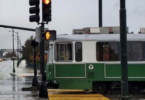By Sara Magalio
BU News Service
BOSTON – Men in suits, briefcases in hand, shuffle into train cars to the city each morning, only to reverse the process in the evening and repeat the monotonous cycle for five straight days.
This may have been the norm for commuting in generations past, but public transit advocates assert that this is no longer the main use for public transport to and from Massachusetts’ Gateway Cities, and it is time for the MBTA to adapt to the modern commuter.
“If you have a system that was built for people commuting into Boston in the 1950s, it was typically a white male commuting into Boston to that 9-to-5 job. That doesn’t exist as much anymore, but that’s the way our transit systems are still designed and prioritized,” said Tracy Corley, a board member of TransitMatters, an organization that works to foster sustainable, equitable and reliable public transportation in and around Boston.
Improving the function and ecological efficiency of transit to and from Massachusetts’ Gateway Cities was a central topic of a forum hosted Tuesday night at Boston University.
Ari Ofsevit, a TransitMatters board member and senior associate for the Institute for Transportation and Development Policy, reassured residents that “not everything is bad,” but said that Massachusetts needs to think in the long term in making changes to its transit systems, especially when working within the constraints of the two-year legislative session.
“We can’t snap our fingers and get new buses,” Ofsevit said. “We can’t snap our fingers and get new train cars, and we can’t go down to Walmart and buy a new signal system.”
But thinking about the future also requires looking at the past, and Ofsevit noted that in the 1970s, the commuter rail system carried about a tenth of the number of passengers it carries today.
“The Worcester line, for instance, had three trains in in the morning and three trains out in the evening, and that’s it,” Ofsevit said. “So we rebuilt the commuter rail system, and we really got it to a point where by 1990 it was close to as many people as some of the highways at rush hour.”
Today, according to the MBTA website, there are 20 trains in and 20 trains out on weekdays going between South Station and Worcester. These trains start as early as 4:40 a.m. and stop running as late as 12:30 a.m., and the time between trains fluctuates from about 30 minutes to two hours, depending on the time of day.
Since the ’90s, however, Ofsevit and Corley said, transit improvements to and from Gateway Cities have stagnated. They recommended using existing infrastructure to increase the number of trains in the middle of the day and reduce fares, to entice more people to use mass transit and to accommodate more kinds of passengers, such as part-time workers, students going to class, people running errands and elderly people for whom driving is no longer an option.
“We can change our commuter rail from a shuttle system to get people from the suburbs into jobs in downtown Boston into a true bidirectional, fast, frequent, all-day service that people can actually afford,” Corley said.
After the forum, Ofsevit noted that Worcester has done a “really good job” building transit-oriented development near Union Station, but between track and signal improvements, MassTransit thinks it is possible to see a train to Boston come every hour and take an hour to arrive.
Ofsevit mentioned the potential impact on Worcester public transit of upcoming highway construction removing the Massachusetts Turnpike viaduct from the Allston interchange to the Commonwealth Avenue Bridge in Boston.
“The Worcester rail corridor really links the community together, especially since the turnpike bypasses Worcester and the train comes right into the middle of Worcester, so this can be a catalyst for development,” Ofsevit said.
Corley also noted that the cost to commute using mass transit is not sustainable for many residents of Gateway Cities.
She cited a 2019 MassINC report that showed a Worcester commuter pays $4,656 each year, more than 13% of the city’s median household income, for commuter rail fares to Boston.
Looking to the future, the environmental impact of public transit was of paramount concern for TransitMatters advocates and area legislators.
Corley said that when it comes to dealing with rising sea levels, greenhouse gas emissions and air pollution that causes respiratory illnesses and related diseases, opting for mass transit over taking a car can help reduce these emissions. Implementing improved technologies for mass transit, such as electric rail cars and buses, is the next step in combating the impact of transit on the climate, she said.
“We have three of the top asthma capitals in Massachusetts. Springfield consistently being No. 1, Boston is No. 8 and, for some reason, Worcester dropped from 11 to 30 in one year. I don’t know if that’s because their air quality is getting better or the rest of the country is getting that much worse,” Corley said.
“If we really want to address climate as our most pressing issue, we want to make sure that we have systems that are flexible, that are resilient, and understand that we are going to need to make modifications in the near future,” she added.
In January, the Massachusetts Senate passed bill S.2476, which if made into law would require the MBTA to buy and lease only zero-emissions vehicles starting in 2030 and to have a completely zero-emissions bus fleet by the end of 2040.
Sen. Anne Gobi, D-Spencer, noted that as technology improves, electric cars become more affordable and the infrastructure to charge those cars catches up, this will be a more viable option for Massachusetts residents.
Until then, she believes state government needs to take the initiative and electrify its public transportation and build the charging stations that will be needed to facilitate a future influx of electric vehicles.
“The MBTA tends to be the largest user of fossil fuels right now in our state,” Gobi said. “With this change looking toward the electrification of buses, for many, electric cars tend to be out of people’s price range, so it’s important for us to look at how we can reduce emissions for our transit now.”
Sen. Michael Moore, D-Millbury, also spoke to the possibility of adding more routes with the electrification of MBTA buses, saying, “This would allow us to increase services, while also impacting our carbon emissions in a positive way.”
Corley also emphasized that busing, local and commuter rail are all intertwined, and that improvements to scheduling, pricing and the ecological impact for one branch impacts all components of this interconnected network.
“You can make changes to the rail system, but if you don’t make changes to the bus system and the other ways that people get to the train, then the changes won’t have any impact,” Corley said. “The more that we can get people to use trains and buses, this could make a huge impact on the climate.”
This article was originally published in The Telegram.




